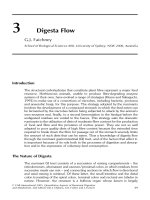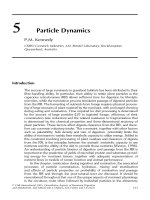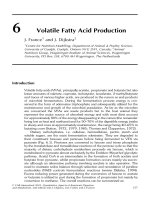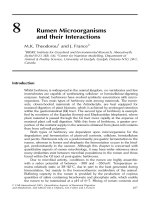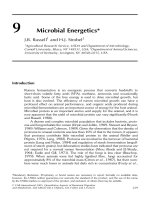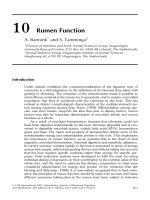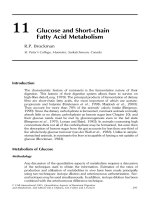Aspects of the ecology of intertidal barnacles on the shores of peninsular malaysia and singapore
Bạn đang xem bản rút gọn của tài liệu. Xem và tải ngay bản đầy đủ của tài liệu tại đây (9.74 MB, 117 trang )
ASPECTS OF THE ECOLOGY OF INTERTIDAL
BARNACLES ON THE SHORES OF PENINSULAR
MALAYSIA AND SINGAPORE
LEE WAN-JEAN
(B.SC. (HONS), NUS)
THIS THESIS IS SUMITTED FOR THE DEGREE OF
MASTERS OF SCIENCE
DEPARTMENT OF BIOLOGICAL SCIENCES
NATIONAL UNIVERSITY OF SINGAPORE
2005
Acknowledgements
This project was supported by the National University of Singapore research
grant R-154–000–160–101. I would like to thank the Economic Planning Unit of
Malaysia (Permit number: 40/200/19 SJ.1048) and National Parks Board of Singapore
(Permit number: NP/RP135) for granting access to study sites in Malaysia and
Singapore. Lady Yuen-Peng McNeice kindly funded my participation at the 6th
International Larval Biology Conference in June 2004 – an experience which proved
very helpful in the course of my research. I am grateful to Dr. Ruth O’Riordan for
giving me the wonderful opportunity to take part in this project and her patient
mentorship right from my Honours year. The completion of this project was not
possible if not for the generous support of Professor Chou Loke Ming. Drs. Anthony
J. Underwood and M.G. Chapman of the University of Sydney contributed valuable
guidance and criticisms during their Experimental Design courses. Various enjoyable
discussions with James Guest, Priscila Neus and Peter Todd have also improved this
dissertation. I also thank members of the Marine Biology Laboratory supporting my
work over the last two years. Lastly, I must express my gratitude to the following
people for helping with data collection, assistance and friendship in the field:
Abigayle Ng, Dionne Teoh, Elsie Wong, Esther Au-Yong, Hwang Wei Song,
Jani Tanzil, Kathy Su, Koh Li Ling, Lim Cheng Puay, Malcom Soh, Michelle Chng,
Ruth and Neil Ramsay, Tan Heok Hui, and my fantastically supportive family.
i
Table of Contents
Acknowledgements.............................................................................................................. i
Table of Contents................................................................................................................ ii
Summary ............................................................................................................................ iv
List of Tables ..................................................................................................................... iv
List of Figures ................................................................................................................... vii
CHAPTER 1. General Introduction.....................................................................................1
1.1. General ecological background ............................................................................1
1.2. Rocky shore ecology in the tropics.......................................................................5
1.3. Aims of this study .................................................................................................7
CHAPTER 2. General Methods...........................................................................................9
2.1. Rocky shores of southern Peninsular Malaysia and Singapore ............................9
2.2. Climate of Peninsular Malaysia and Singapore ..................................................11
2.3. Study organisms..................................................................................................12
2.4. Study sites and general sampling design ............................................................15
2.5. Sampling methodology .......................................................................................21
2.6. General statistical analyses .................................................................................24
CHAPTER 3. Spatial and Temporal Variation in the Density and Mortality of
Chthamalus malayensis...................................................................................25
3.1. Introduction.........................................................................................................25
3.2. Survey design and methods ................................................................................28
3.3. Data analysis .......................................................................................................29
3.4. Results.................................................................................................................29
3.5. Discussion...........................................................................................................34
ii
CHAPTER 4. Spatial and Temporal Variation in the Recruitment of Chthamalus
malayensis .......................................................................................................42
4.1. Introduction.........................................................................................................42
4.2. Sampling design and methods ............................................................................44
4.3. Data analysis .......................................................................................................45
4.4. Results.................................................................................................................45
4.5. Discussion...........................................................................................................50
CHAPTER 5. Vertical Pattern of Recruitment of Balanus spp. ........................................58
5.1. Introduction.........................................................................................................58
5.2. Sampling design and methods ............................................................................61
5.3. Data analysis .......................................................................................................63
5.4. Results.................................................................................................................64
5.5. Discussion...........................................................................................................74
CHAPTER 6. General Discussion .....................................................................................80
Papers Published/Submitted Arising from this Work........................................................83
References..........................................................................................................................84
iii
Summary
Spatial and temporal variation of population dynamics and recruitment of
intertidal barnacles Chthamalus malayensis Pilsbry and Balanus spp. on rocky shores
of southern Peninsular Malaysia and Singapore were investigated from August 2003
to March 2005. Nested sampling designs used enabled multiple spatial scales to be
examined simultaneously and all experiments were repeated over one year to reveal
possible temporal trends.
Density, mortality rate and recruitment of C. malayensis were examined over
three spatial scales in Malaysia and Singapore from August 2003 to August 2004.
Three Coasts (100s of kilometres apart) facilitated examination of variability over a
regional scale. Two Shores, 1-10s kilometres apart, were nested within each Coast,
and two Sites separated by tens of metres within each Shore were selected.
Abundance and mortality rates were measured by tracking barnacles over three-month
periods (Quarters). Analysis of variance (ANOVA) detected significant Site×Quarter
interaction (P<0.05) for both barnacle density and mortality, while post-hoc StudentNewman-Keuls (SNK) tests revealed that site differences (P<0.05) occurred only on
Malaysian Shores, and Shores within Coasts did not always exhibit Site differences
during the same Quarter. Significant temporal fluctuations (P<0.05) of density
occurred only in Malaysia, while one Site in Singapore, in addition to Malaysian
Sites, showed significant Quarterly (P<0.05) variation in mortality. C. malayensis
recruitment was quantified monthly within quadrats cleared of all fauna. Recruitment
was observed consistently at all Shores, albeit at varying levels. ANOVA found
significant Site×Month interaction, and most significant Site variations (SNK:
P<0.05) occurred in Malaysia where Site variations were not always present
iv
concurrently at both Shores. The results suggest that local, within-Shore mechanisms
are more important than regional processes, and varied throughout the year.
Vertical patterns of fortnightly and monthly recruitment of Balanus spp.
were examined in Singapore from March 2004 to March 2005. Vertical distribution of
recruits was compared to that of established populations to determine whether
zonation of barnacles is established by recruitment. Two Shores in Singapore, located
kilometres apart were selected, within which Sites hundreds of metres apart were
chosen. Perspex recruitment panels were attached at three Levels within the vertical
range of Balanus spp., and the numbers of recruits found after two and four weeks
were quantified. The experiment was repeated over one year to determine whether the
vertical pattern. Vertical variation of fortnightly and four-weekly recruitment
depended on Site (ANOVA: Level×Site; P<0.05), though the interaction was not
found in some months/fortnights. The most common vertical pattern of recruit density
after two and four weeks was low>middle>high – in contrast to the zonation observed
in adults (highest abundance at middle level). The findings indicated that vertical
distribution of Balanus spp. on the shores studied is not determined by recruitment.
This study showed that population and recruitment dynamics of C. malayensis
and Balanus spp. varied on small spatial scales and within a year. Comparisons on
larger scales (beyond tens of metres) might be confounded by such local variations.
Therefore, future studies should be designed with adequate small-scale replication and
also consider the temporal variability of patterns and processes.
v
List of Tables
Table 2.1 Summary of spatial and temporal scales examined for population and
recruitment patterns................................................................................................... 16
Table 2.2 Locations of C. malayensis study sites. ............................................................ 17
Table 2.3 Locations of Balanus spp. study sites............................................................... 20
Table 3.1 ANOVA of C. malayensis densities. ................................................................ 31
Table 3.2 Occurrence of significant variation of C. malayensis density between sites.... 31
Table 3.3 Sites where significant variation of C. malayensis density and percentage
mortality among quarters were detected.................................................................... 31
Table 3.4 ANOVA of C. malayensis percentage mortality. ............................................. 33
Table 3.5 Occurrence of significant variation of C. malayensis density between sites.... 33
Table 4.1 ANOVA of C. malayensis monthly recruitment observed every full moon. ... 46
Table 4.2 Occurrence of significant variation of C. malayensis recruitment between
sites............................................................................................................................ 46
Table 5.1 ANOVA and SNK tests of adult Balanus spp. densities. ................................. 65
Table 5.2 Occurrence of significant Level×Shore and Level×Site(Shore) interaction of
Balanus spp. 2-weekly recruitment. .......................................................................... 67
Table 5.3 Occurrence of significant Level×Shore and Level×Site(Shore) interaction of
Balanus spp. 4-weekly recruitment revealed by ANOVA. ....................................... 67
vi
List of Figures
Figure 2.1 Map showing study sites in southern Peninsular Malaysia. .......................10
Figure 2.2 Map showing study sites in Singapore. ....................................................11
Figure 2.3 Mean monthly dry bulb temperatures at Port Dickson, Mersing and St.
John's Island.................................................................................................................12
Figure 2.4 Chthamalus malayensis adults. ..................................................................13
Figure 2.5 Balanus spp. adults.....................................................................................14
Figure 2.6 Chthamalus malayensis metamorph (<1 month old). ................................15
Figure 2.7 Balanus spp. metamorph (< 1 month old). .................................................15
Figure 2.8 Blue Lagoon on the West Coast of Peninsular Malaysia. ..........................17
Figure 2.9 Tanjong Pelandok on the West Coast of Peninsular Malaysia...................17
Figure 2.10 Tanjong Resang on the East Coast of Peninsular Malaysia. ....................18
Figure 2.11 Tanjong Leman on the East Coast of Peninsular Malaysia......................18
Figure 2.12 Breakwater at East Coast Park on the southern Coast of Singapore. .......19
Figure 2.13 Rocky shore on St. John’s Island of the southern Coast of Singapore.....19
Figure 2.14 Breakwater at Pasir Ris. ...........................................................................20
Figure 2.15 Rocky shore at Changi Point. ...................................................................21
Figure 3.1 Mean number of C. malayensis at the beginning of each Quarter. ............30
Figure 3.2 Mean percentage mortality C. malayensis for each Quarter. ....................33
Figure 4.1 7cm×7cm clearing with C. malayensis recruits (≤1 month old). ...............45
Figure 4.2 Mean monthly recruitment of C. malayensis between September 2003 and
August 2004. ................................................................................................................47
Figure 4.3 Cumulative number of C. malayensis cyprids and metamorphs collected
over one year from each shore. ....................................................................................50
Figure 5.1 Perspex recruitment panels deployed at 3 Levels.......................................63
Figure 5.2 Mean number of adult Balanus spp. at different Levels in March 2004....64
vii
Figure 5.3 Mean number of cyprids and metamorphs of Balanus spp. observed after
one nocturnal high tide and diurnal high tide at Changi Point. ...................................66
Figure 5.4 Mean 2-weekly Balanus spp. recruitment at three Levels between March
2004 and March 2005 at Pasir Ris. ..............................................................................70
Figure 5.5 Mean 4-weekly Balanus spp. recruitment at three Levels between May
2004 and March 2005 at Pasir Ris. ..............................................................................71
Figure 5.6 Mean 2-weekly Balanus spp. recruitment at three Levels between March
2004 and March 2005 at Changi Point. .......................................................................72
Figure 5.7 Mean 4-weekly Balanus spp. recruitment at three Levels between May
2004 and March 2005 at Changi Point ........................................................................73
viii
CHAPTER 1. General Introduction
1.1. General ecological background
A major objective of ecology is to explain the variability of populations and
communities (Farrell et al., 1991; Carroll, 1996; Benedetti-Cecchi et al., 2000; Delany
et al., 2003). Mechanisms that structure populations and communities can only be
determined through experimental manipulations to test competing hypotheses
(Underwood, 1981; Underwood et al., 2000). As a result of the ‘rise of
experimention’ since the 1960s (Connell, 1961a, b; Underwood, 2000), recent
research on intertidal rocky shores has contributed substantially to the general
development of ecological theory (Underwood and Denley, 1984; Roughgarden et
al., 1988; Menge and Branch, 2001; Benson, 2002). Intertidal rocky shores have been
intensively utilized for field experiments partly because of their presence along many
coastlines, accessibility, and the relative ease with which well-replicated experimental
treatments can be deployed (Roughgarden et al., 1988; Farrell et al., 1991; Lively et
al., 1993). The abundance of small sessile and slow-moving organisms also allows
populations and communities to be manipulated systematically to reveal interactions
within and among species (Connell, 1972; Roughgarden et al., 1988). On the other
hand, the experimental approach will be fruitful only if it is accompanied with, if not
preceded by, good descriptive data from which valid models can be derived and tested
in the field (Underwood, 1981; Lubchenco et al., 1984; Menge and Farrell, 1989;
Underwood et al., 2000). There is large body of qualitative and quantitative work on
temperate rocky shore communities (e.g. Oregon, USA (Menge, 2000), Western
Europe (Jenkins et al., 2001; O'Riordan et al., 2004), also see references in
(Lubchenco et al., 1984)), enabling the effective development of ecological models.
1
One of the most described and studied patterns of intertidal habitats is the
vertical zonation of the benthos (Stephenson and Stephenson, 1949; Lewis, 1964;
Stephenson and Stephenson, 1972; Menge and Branch, 2001; also see Benson, 2002
for an historical account), and it formed the basis of some of the first manipulative
field experiments (e.g. Connell, 1961a, b, 1970; Dayton, 1971; Paine, 1974;
Underwood and Denley, 1984). Among the major taxa found on rocky shores,
barnacles are particularly suited for ecological studies (Connell, 1985a; Roughgarden
et al., 1988; Todd, 1998). They are major space-occupiers of rocky shores worldwide
(Stephenson and Stephenson, 1949), individual barnacles can be mapped and tracked
by regular census and natural population densities can be manipulated (Connell,
1961a, 1985a; Todd, 1998). Using intertidal barnacles as models, early researchers
derived a series of generalizations on population dynamics – particularly on the
determination of upper and lower limits of distribution (for reviews see Underwood
and Denley, 1984; Underwood, 1985; Benson, 2002). Processes acting on adults such
as predation, competition and mortality from physical factors were emphasized when
explaining variabilities in abundance and distribution of intertidal populations
(Connell, 1961a, b; Dayton, 1971), while implications of juvenile mortality in benthic
marine invertebrates had also been examined (for reviews see Gosselin and Qian,
1997; Hunt and Scheibling, 1997).
Nevertheless, the elevation of generalizations from small-scale studies to the
status of ‘paradigms’ without examination of alternative hypotheses have been
criticized, and it is widely agreed that early models overlooked the influence of larval
settlement and recruitment on population and community dynamics (Underwood and
Denley, 1984; Young, 1987; Sale, 1990; Menge, 2000). Definitions of settlement and
recruitment vary. Settlement of marine benthic organisms refers to the point when an
2
individual first takes up permanent residence on the substratum (Keough and Downes,
1982; Connell, 1985a). In the case of the sessile organisms such as barnacles, it is
when the planktonic larva cements itself to the surface. However, as pointed out by
Connell (1985a), many studies examining settlement in fact measured recruitment,
which is subject to the definition of the investigator. Recruitment of a population is a
combination of settlement and early mortality, and is defined as the number of settlers
that have survived to be observed (Keough and Downes, 1982; Connell, 1985a).
Many marine species are open populations with complex two-phase life histories
consisting of sessile adults and pelagically dispersed larvae (Gaines and
Roughgarden, 1985; Roughgarden et al., 1985; Roughgarden et al., 1988; Hyder et al.,
2001), and those early models did not consider larval supply to be limiting
(Southward and Crisp, 1954, 1956; Connell, 1961a, b; Gaines and Roughgarden,
1985; Roughgarden et al., 1988). Consequently, since the 1980s, there has been
increasing attention on the importance of settlement and recruitment patterns on the
distribution of adults (e.g. Underwood and Denley, 1984; Caffey, 1985; Connell,
1985a; Gaines and Roughgarden, 1985; Menge, 2000; Delany et al., 2003; Jeffery,
2003), and the term ‘supply-side ecology’ was coined reflecting the growing interest
(Lewin, 1986; Roughgarden et al., 1987; Young, 1987; Underwood and Fairweather,
1989).
‘Supply-side ecology’ was regarded by Young (1987) and Underwood and
Fairweather (1989) as a renewal of the understanding of the role of recruitment in
ecology, rather than a novel concept. Similarly, other theories such as those on the
role of positive interactions have been revived, and efforts have been made to include
these processes in current models of population and community dynamics (Bertness,
1989; Bertness and Leonard, 1997; Bruno and Bertness, 2001; Bruno et al., 2003).
3
Recent studies have also directed their research towards comparing the relative
importance of settlement, recruitment and post-settlement mortality, that is
investigating whether adult patterns are established at settlement and/or recruitment,
and if post-recruitment processes such as predation and competition modify those
patterns (Connell, 1985a; Leonard et al., 1999; Menge, 2000; Delany et al., 2003;
Jeffery, 2003). Furthermore, with the large amount of empirical data on the vital rates
of model populations – especially those of intertidal barnacles - accumulated,
mathematical demographic models integrating settlement patterns were formulated
(Gaines and Roughgarden, 1985; Roughgarden et al., 1985; Roughgarden et al., 1988;
Connolly and Roughgarden, 1998; Svensson et al., 2004). Efforts have also been
made to collect and integrate quantitative data across regions (Jenkins et al., 2000;
O'Riordan et al., 2004; Jenkins et al., 2005), continents (Kelaher et al., 2004; Schiel,
2004), latitudinal and climatic gradients (Bertness et al., 1981; Menge and
Lubchenco, 1981; Brosnan, 1992; Connolly et al., 2001), to generalize patterns and
processes on large spatial scales.
The aforementioned studies formed part of an increasing appreciation of scale
in examining ecological phenomena. Due to the patchiness of natural systems valid
observations, experiments and generalizations can only be made if the spatial and
temporal scales at which processes operate are identified (Menge and Farrell, 1989;
Levin, 1992; Underwood, 1997; Underwood and Chapman, 1998; Benedetti-Cecchi,
2000, 2001). As discussed earlier, the most commonly studied spatial pattern in the
intertidal is vertical zonation, less common are experiments looking at horizontal
variations (Benedetti-Cecchi, 2001; Davidson, 2005), particularly large scale patterns.
The latter are important in intertidal ecology as pelagic larvae can be long-lived and
widely dispersed, and therefore subjected to oceanic and climatic influences (Gaines
4
et al., 1985; Lagos et al., 2005). Though it is possible to review existing studies from
a range of locations (e.g. Connell, 1985a; Menge, 1991), interpretation of results can
be confounded by differences in methods and scales (Underwood and Fairweather,
1985; Underwood and Petraitis, 1993; Menge, 2000) – particularly in recruitment
studies where there are often discrepancies in definitions and methodology (Keough
and Downes, 1982; Connell, 1985a; Minchinton and Scheibling, 1993a). An ideal
design should investigate variations at a range of scales simultaneously, using
identical methods at different locations. A nested or hierarchical sampling design
enables the examination of variations at different scales and several workers have
examined local and regional variations in population dynamics and recruitment
patterns of intertidal barnacles in western Europe using nested analysis of variance
(ANOVA) (Underwood, 1997; Underwood and Chapman, 1998; Jenkins et al., 2000;
Jenkins et al., 2001; O'Riordan et al., 2004). The juxtaposition of different studies to
generalize ecological processes is also problematic when experiments were not
repeated through time to unconfound temporal variations (Underwood and Petraitis,
1993; Berlow and Navarrete, 1997). Studies have found within-year (Connell, 1970;
Raimondi, 1990; Jenkins et al., 2001) and between-year (Lubchenco et al., 1984;
Minchinton and Scheibling, 1991; Jeffery, 2003) differences in population dynamics
of intertidal barnacles, therefore a comprehensive sampling programme should also
take into account temporal as well as spatial scales (Lively et al., 1993; Underwood
and Petraitis, 1993; Underwood and Chapman, 2000).
1.2. Rocky shore ecology in the tropics
While efforts are being made to improve and integrate ecological studies on
rocky shores, it is apparent that, to date, the majority of the intertidal research have
been carried out on temperate shores and tropical shores are under-represented in the
5
existing scientific literature (Farrell et al., 1991). This is despite the fact that
assemblages and populations comparable to temperate rocky shores can be found in
the tropics, and models based on temperate habitats can be tested on low-latitude
shores (Bertness et al., 1981; Lubchenco et al., 1984; Menge, 1991; Hutchinson and
Williams, 2001; Coates, 2002; Chan and Williams, 2003). Therefore apart from
improving the spatial extent of individual studies, it is also necessary to increase the
range of habitats and locations in which hypotheses are tested (Underwood and
Fairweather, 1989; Underwood, 2000; Kelaher et al., 2004). The need for quantitative
evaluations of ecological processes acting on tropical shores is especially pertinent
because the limited number of tropical studies have revealed key differences to
temperate shores.
Menge and Farrell (1989) defined tropical shores as regions experiencing
temperatures between 20 to 30oC, though coasts in more temperate areas such as
Hong Kong have also been described as tropic (e.g. Williams, 1994). Tropical shores
are commonly characterized by high levels of free space, together with low
abundance of foliose macroalgae and sessile animals (Menge and Lubchenco, 1981;
Lubchenco et al., 1984; Brosnan, 1992). Work conducted in the Bay of Panama
suggested that consumer pressure was significantly more intense in the tropics than in
temperate regions, though experiments conducted on the Pacific coast of Costa Rica
revealed otherwise (Menge and Lubchenco, 1981; Lubchenco et al., 1984; Sutherland,
1990). Disparities in the level of barnacle recruitment between widely separated
shores were also recorded (Sutherland, 1990). Lubchenco et al. (1984) reported that a
rocky shore community in the Bay of Panama remained constant over ten years, but
another assemblage found in Costa Rica was more variable (Ortega, 1987). In
contrast, the shores of Hong Kong experience a tropical monsoonal climate where the
6
intertidal community changes with the onset of summer and settlement is also
seasonal (Williams, 1993, 1994; Chan and Williams, 2003). Though limited, such
studies revealed the spatial and temporal heterogeneity within the tropical region,
which, together with fundamental differences with temperate shores, necessitate more
rigorous investigations of ecological dynamics on tropical shores. A survey of
published literature also shows that systematic experimental studies of tropical rocky
shores have been confined to central America, Hong Kong and Australia (see above
for references) – all relatively distant from the equator (studies done in Bay of
Panama at 9oN were the nearest to the equator) and were often limited to within a
single shore. Shores of Peninsular Malaysia and Singapore are located at relatively
lower latitudes and are therefore suited for examining the generality of established
ecological theories based on experiments in the temperate area, but not previously
tested at the equator.
1.3. Aims of this study
As discussed earlier in this chapter, investigations of ecological processes and
theories require quantitative information on patterns and distributions. There are
published descriptions of Malaysian and Singaporean shores (Purchon and Enoch,
1954; Chuang, 1961; Lee, 1966; Ewing-Chow, 1967; Purchon and Purchon, 1981;
Leong, 1984). These surveys noted that rocky communities in Malaysia and
Singapore fitted general zonation schemes of temperate shores and reported that the
presence of intertidal barnacles Chthamalus and Balanus spp. They were qualitative
unrepeated surveys (Purchon and Enoch, 1954; Chuang, 1961; Lee, 1966; EwingChow, 1967) and no workers determined the processes causing the patterns. Though
Suhaimi (1965) and Yang (1967) conducted short-term preliminary studies on the
ecology (including recruitment patterns) of intertidal and subtidal Balanus spp. in
7
Singaporean waters. While the distribution of Chthamalus species on Indo-Malayan
shores have been recently reviewed (Southward and Newman, 2003). This research
used these two species as study models to provide descriptive data on population
distribution and recruitment dynamics from which scales of variations can be
identified. The main objectives of this study are to:
1. Describe the distribution, abundance and mortality rates of the intertidal barnacle
Chthamalus malayensis over a range of temporal and spatial scales (tens of metres
to hundreds of kilometres) (Chapter 3).
2. Examine temporal and spatial patterns of recruitment of C. malayensis and
Balanus spp. (Chapters 4 and 5).
Central to this study is the testing of hypotheses on spatial scales of variability
of distribution and recruitment patterns, and whether the patterns are temporally
consistent by sampling repeatedly over one year. Specific models and predictive
hypotheses will be discussed in the Introductions of Chapters 3, 4 and 5. This is the
first time variability of population densities and recruitment have been tracked on
shores hundreds of kilometres apart on the west and east coasts of Peninsular
Malaysia and Singapore over an extended period of time (Chapters 3 and 4), and
influence of recruitment on determining vertical distribution has been investigated in
Singapore (Chapter 5) . Comparisons of relative recruitment patterns with adult
abundance patterns will reveal possible influences of recruitment on the determination
of barnacle population dynamics, and facilitate subsequent development and testing of
explanatory models of causal mechanisms.
8
CHAPTER 2. General Methods
2.1. Rocky shores of southern Peninsular Malaysia and Singapore
The west coast of Peninsular Malaysia faces the Straits of Malacca while the
shores on the east coast of the Peninsula face the South China Sea (Figure 2.1).
Singapore is located at the tip of the Peninsula, from which it is separated by the
Johore Straits, and the southern coast faces the Singapore Straits (Figure 2.2). The
shores of the region experience semi-diurnal tides with tidal ranges of approximately
3m. Chuang (1961) noted that there are relatively few ‘pure rocky shores’ along the
Peninsular Malaysian and Singaporean coasts, and rocky shores usually occur in
patches in mainly sandy and/or muddy habitats (see Purchon and Enoch, 1954;
Chuang, 1961; Lee, 1966; Ewing-Chow, 1967; Tan, 1995 for qualitative description).
While many rocky shores on the Peninsula described in earlier studies (e.g. Chuang,
1961) remain today, much of Singapore’s coastline have been modified through
extensive reclamation, particularly along the southern coast (Hill, 1973; Tan, 1995).
The southern coastline consists mainly of concrete seawalls and granite breakwaters
and artificial sandy beaches, though natural rocky habitats can still be found on
offshore islands and at Labrador Beach and Changi Point on the mainland (Figure
2.2).
9
Figure 2.1 Map showing study sites in southern Peninsular Malaysia. RS: Tanjong Resang; LM:
Tanjong Leman; BL: Blue Lagoon; PL: Tanjong Pelandok.
10
Figure 2.2 Map showing study sites in Singapore. SJ: St. John’s Island; ECP: East Coast Park;
PR: Pasir Ris; CG: Changi Point.
2.2. Climate of Peninsular Malaysia and Singapore
Peninsular Malaysia and Singapore experience an equatorial, monsoonal
climate. The east coast of the Peninsula is exposed to the north-east monsoon that
occurs from November to February of the following year while the west coast
experiences the south-west monsoon from May to September (see Chuang, 1961;
Nieuwolt, 1973; Ooi and Chia, 1974; Chua, 1984 for details). As Singapore is located
on the southern tip of the Peninsula, it is affected by both monsoons annually. The
coastal oceanography, prevailing winds and rainfall of the area are strongly influenced
by monsoons, though Sumatra shelters the west coast and Singapore from strong
waves during the south-west monsoon (Tan, 1995). Ambient air and water
temperatures are not significantly affected. Data provided by the Malaysian and
Singaporean Meteorological Services indicated that monthly mean air temperature
near the study sites ranged from 26oC to 29 oC from August 2003 to July 2004
(Figure 2.3). Surface water temperatures are also relatively constant, fluctuating
11
between 27oC to 30 oC, varying with the occurrence of monsoons (Tham, 1953; Chua,
1984).
29.5
29.0
28.5
o
Temperature ( C)
28.0
27.5
27.0
26.5
26.0
25.5
25.0
24.5
24.0
Aug03
Sep03
Oct03
Nov03
Dec03
Port Dickson
Jan04
Feb04
Mersing
Mar04
Apr04
May04
Jun- Jul-04
04
St. John's Island
Figure 2.3 Mean monthly dry bulb temperatures at Port Dickson, Mersing and St. John's Island.
2.3. Study organisms
Chthamalus malayensis Pilsbry (Figure 2.4) and Balanus spp. (Figure 2.5)
were chosen as models for this study as they are the main space occupiers along the
middle and upper intertidal on the shores of the region (personal observations;
Purchon and Enoch, 1954; Lee, 1966; Ewing-Chow, 1967), and occurred in sufficient
densities for population and recruitment studies. Southward and Newman's (2003)
review of Chthamalus barnacles in the region indicated that the Chthamalus species
found intertidally in Peninsular Malaysia and Singapore is Chthamalus malayensis,
which is also distributed throughout the Indo-west Pacific. Compared to temperate
species of Chthamalus, relatively little research has been conducted on C. malayensis,
though some work on its ecology and biology have been published in recent years
(Yan and Chan, 2001; Coates, 2002; Yan and Miao, 2004; Koh et al., 2005). The
12
majority of Balanus species found on intertidal rocky shores and breakwaters in
Singapore are B. amphitrite, while other species (B. cirratus and B. reticulatus on the
lower intertidal) have also been found to occur within the same habitats (pers. comm.
Cai Y.X.; Suhaimi, 1965; Yang, 1967; personal observations). B. amphitrite is a
circumtropical fouling species, which extends up to temperate waters (Fernando,
1999). As B. amphitrite is a major biofouler, extensive research has been directed
towards investigating the species’ mechanisms of settlement, development and
reproduction (e.g. Rittschof et al., 1984; Anil et al., 1995; Khandeparker et al., 2002;
Thiyagarajan et al., 2003a; Desai and Anil, 2004), though many of the studies were
carried out on subtropical/temperate shores or in the laboratory (but see Suhaimi,
1965; Yang, 1967; Ng et al., 2005 for work on Singaporean waters; and Fernando,
1999 for a review on reproduction of tropical species).
Figure 2.4 Chthamalus malayensis adults.
13
Figure 2.5 Balanus spp. adults.
Chthamalus and Balanus spp. have been observed to exhibit vertical zonation
on temperate shores (Connell, 1961b; Stanley and Newman, 1980; Wethey, 1983b),
but co-occurrence of the two genera was only reported by Lee (1966) and observed at
East Coast Park and Changi Point (see later section for description of study sites)
among the sites investigated for this project. While chthamalid and balanid
metamorphs could be distinguished in the field using a 20× microscope, and the
former identified as C. malayensis (Figure 2.6), the Balanus (Figure 2.7) metamorphs
could not be identified to species. Therefore, for this study, any balanid barnacles
found will be generally regarded as Balanus spp. C. malayensis were found on shores
separated on an appropriately large scale (hundreds of kilometres) therefore
facilitating the study of horizontal patterns (Chapters 3 and 4). As preliminary studies
found Balanus spp. recruitment to be relatively greater and more consistent than C.
malayensis in Singapore (see Results in Chapter 4 and 5), the former was chosen to be
the model organism used for investigations of vertical recruitment patterns on a local
scale in Singapore (Chapter 5).
14
200µm
Figure 2.6 Chthamalus malayensis metamorph (<1 month old).
200µm
Figure 2.7 Balanus spp. metamorph (< 1 month old).
2.4. Study sites and general sampling design
As the experimental designs used for all aspects of this study are similar in
logic, they will be presented together in this section, with additional information
provided in the Methods section of the relevant chapters. Hierarchical designs were
employed to examine C. malayensis and Balanus spp. population and recruitment
dynamics across at least two spatial scales (Table 2.1). The study Sites, Shores and
Coasts were chosen to represent areas separated by the 10/100s m, 1-10s km and 100s
km respectively, consequently, they were all considered random factors (Underwood,
15
1997). For the same reason, only well drained, opened substrata were considered for
sampling, avoiding particularly crevices, rock pools and shaded areas. Appropriate
temporal replication is crucial to interpreting temporal patterns without confounding
(Underwood and Petraitis, 1993; Underwood, 1997), moreover, Minchinton and
Scheibling (1993a) reported that estimates of Semibalanus balanoides Linnaeus
recruitment were influenced by variations in sampling interval as a result of postrecruitment mortality. The minimum sampling interval was decided to be one month
(e.g. from one full moon to the next; Table 2.1), allowing larger temporal patterns
(such as seasonal changes (Underwood, 1997)) to be detected while enabling widely
separated coasts to be sampled around the same period.
Table 2.1 Summary of spatial and temporal scales examined for population and recruitment
patterns.
Spatial scale
Temporal
Vertical
Site
Shore
Coast
Pattern investigated
scale
10s cm
10s/100s m
1-10s km 100s km
C. malayensis density
3
3
3 mo (Quarter)
3 (10s m)
C. malayensis mortality
3
3
3 mo (Quarter)
3 (10s m)
C. malayensis recruitment
Balanus spp. recruitment
3 (10s m)
3 (100s m)
3
3
3
-
3
1 mo
2 wk, 4 wk
C. malayensis patterns were examined over three spatial scales from August
2003 to August 2004 in Malaysia and Singapore. Sites (2 at each Shore, A and B)
were nested in Shores (2 along each Coast), which in turn were nested within Coasts
(3) (Figures 2.1, 2.2, 2.8-2.13, Table 2.2). All shores are natural rocky shores - except
East Coast Park in Singapore, which consists of granite breakwaters - with an
abundance of C. malayensis (see Chapter 3 for distribution patterns). Sampling was
carried out at all Sites during full-moon spring low tides in monthly or three-monthly
intervals (Quarters) over the year, therefore the factor of time (4 levels for density and
mortality analyses; 12 levels for recruitment data) was fixed and orthogonal with Site,
Shore and Coast.
16


